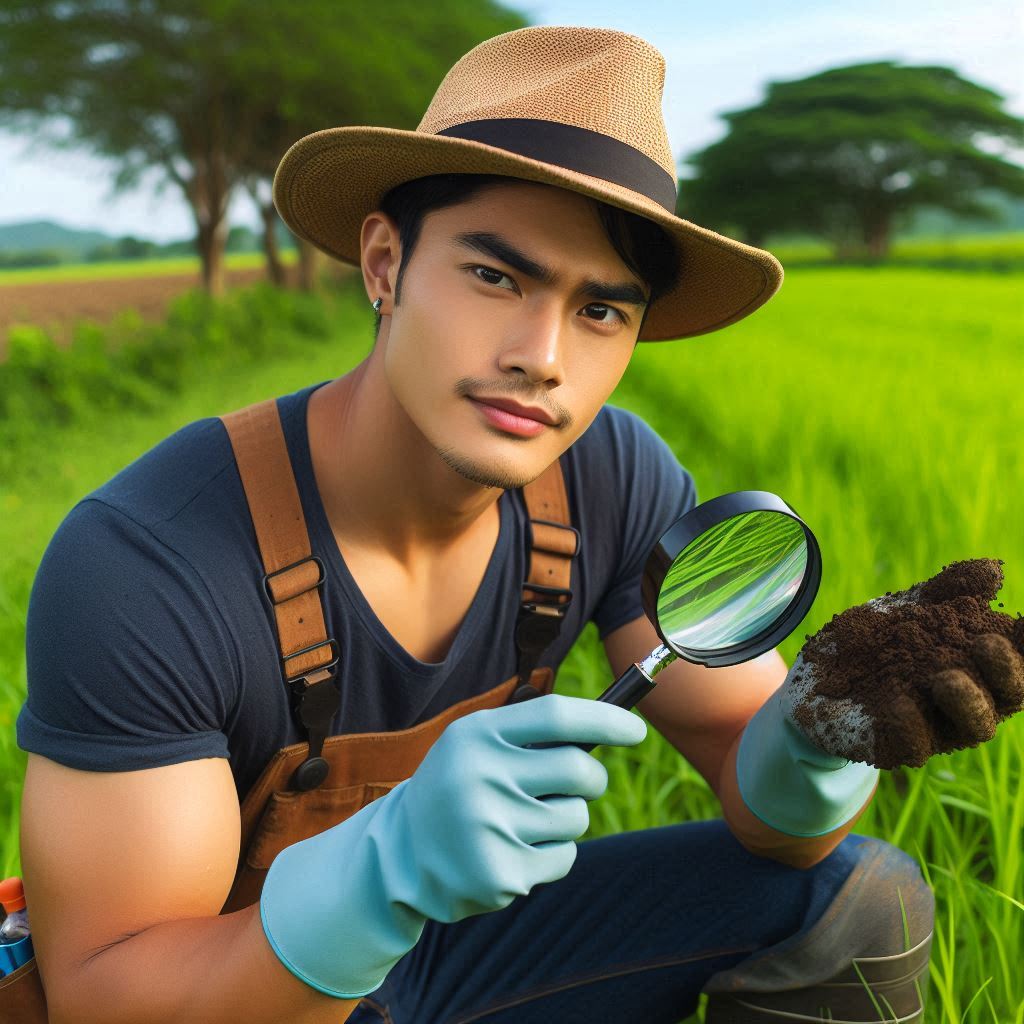Introduction
Soil science education plays a vital role in addressing some of the most pressing global challenges, such as food security, climate change, and environmental sustainability.
Understanding the properties, functions, and management of soil is crucial for maintaining healthy ecosystems, supporting agriculture, and mitigating environmental degradation.
Through soil science education, individuals gain the skills needed to make informed decisions about land use, water management, and conservation practices, all of which are essential for sustaining life on Earth.
In recent years, the availability of online resources for learning about soil science has expanded dramatically.
The rise of digital learning platforms, webinars, research databases, and interactive tools has transformed how soil science education is delivered and accessed.
Whether you are a student, researcher, or professional, these online resources offer flexibility and convenience, enabling you to learn at your own pace and on your own schedule.
This digital shift has also allowed more people worldwide to access high-quality education, regardless of geographic location.
Overview of Soil Science
Define Soil Science and Its Importance
Soil science is the study of soil as a natural resource.
It examines soil’s formation, classification, and mapping.
This discipline plays a crucial role in agriculture, ecology, and environmental science.
Understanding soil is vital for sustainable land management and food production.
The importance of soil science extends beyond agriculture.
Healthy soils support plant growth and filter water.
They also store carbon, mitigate climate change, and provide habitat for organisms.
Soil scientists help manage soil health to promote ecosystem stability and resilience.
Thus, this field contributes significantly to global food security and environmental sustainability.
The Interdisciplinary Nature of Soil Science
Soil science is inherently interdisciplinary.
It combines knowledge from geology, biology, chemistry, and environmental science.
Soil scientists must understand how these fields interrelate.
For example, geology informs soil formation processes, while biology explores soil organisms and their functions.
This multidisciplinary approach enriches our understanding of soil systems.
The Various Subfields within Soil Science
Several subfields exist within soil science, each focusing on different aspects of soil.
Soil physics studies the physical properties and behavior of soil.
This area examines soil structure, density, and moisture retention.
Understanding these properties is essential for effective land use and water management.
Soil chemistry investigates the chemical composition of soils.
It examines nutrient availability, soil acidity, and pollutant interactions.
This knowledge helps in soil fertility management and environmental protection.
By understanding chemical processes, soil scientists can develop strategies for soil remediation and sustainable agricultural practices.
Soil biology focuses on the living organisms within the soil.
This subfield explores microbial communities, fungi, and larger soil fauna.
These organisms play crucial roles in nutrient cycling and organic matter decomposition.
By studying soil biology, researchers can better understand soil health and fertility.
Soil ecology integrates various aspects of soil science.
It studies the interactions between soil organisms and their environment.
Soil ecologists explore how these interactions influence ecosystem functions.
They also assess how human activities affect soil ecosystems and biodiversity.
Another essential subfield is soil conservation.
Soil conservation specialists develop practices to prevent soil erosion and degradation.
They promote sustainable land use practices to maintain soil health.
This subfield emphasizes the importance of protecting soil resources for future generations.
Soil science is a vital field that impacts many aspects of life.
Its interdisciplinary nature allows for a comprehensive understanding of soil systems.
The various subfields contribute to our knowledge of soil formation, health, and conservation.
By investing in soil science education, we can enhance our ability to manage this crucial resource.
Read: Challenges and Rewards: The Dual Life of an U.S. Environmental Scientist
Benefits of Online Resources
Accessibility to a Wide Range of Information and Resources
Online resources provide unparalleled access to a vast array of information on soil science.
Students, educators, and enthusiasts can explore digital libraries, academic journals, and research articles with ease.
This accessibility allows users to tap into the latest findings and developments in the field.
Furthermore, online platforms host videos, webinars, and interactive tools, enriching the learning experience.
With just a few clicks, learners can access global expertise, making soil science education more comprehensive.
Cost-Effectiveness Compared to Traditional Learning Methods
Online resources often offer a more cost-effective alternative to traditional learning methods.
Many high-quality materials are available for free or at a lower cost than physical textbooks and courses.
This affordability allows more people to engage with soil science education.
Institutions can also save on expenses related to physical classrooms and materials.
With online courses, learners can often avoid commuting costs, making education more accessible to a broader audience.
Ability to Learn at One’s Own Pace and Convenience
One of the greatest benefits of online resources is the flexibility they offer.
Learners can choose when and where to study, accommodating their personal schedules.
This self-paced learning approach allows individuals to digest complex topics thoroughly.
Whether someone prefers to spend extra time on challenging concepts or quickly review familiar material, online resources cater to those needs.
This convenience supports a diverse range of learning styles and enhances overall retention of information.
Online resources offer significant advantages for soil science education.
They provide easy access to diverse information, are more cost-effective than traditional methods, and allow learners to study at their own pace.
These benefits contribute to a more inclusive and effective learning environment.
By leveraging online resources, individuals can enhance their understanding of soil science and its importance.
Read: Job Market Trends: Future of Chemistry Jobs in America
Types of Online Resources
Websites Dedicated to Soil Science Education
Numerous websites are dedicated to soil science education, offering a wealth of information.
These sites provide articles, research papers, and educational materials for students and professionals.
Institutions such as universities and government agencies often maintain these resources.
They include databases that allow users to search for specific topics, research findings, and case studies.
These websites also feature blogs and forums where users can engage with experts and peers, enhancing the learning experience.
Online Courses and Webinars
Online courses and webinars are excellent resources for structured learning in soil science.
Many universities and organizations offer courses that cover various aspects of the field.
These courses often include video lectures, reading materials, and assessments.
Participants can gain knowledge at their own pace while interacting with instructors and fellow students.
Webinars provide opportunities to learn from experts in real-time, allowing participants to ask questions and engage in discussions.
This format makes specialized knowledge accessible to a broader audience.
Virtual Labs and Simulations for Hands-On Learning
Virtual labs and simulations offer innovative ways to engage with soil science concepts.
These resources provide interactive experiences that mimic real-world scenarios.
Students can conduct experiments and analyze data without needing physical lab space or materials.
Virtual labs allow users to visualize complex processes, such as soil erosion or nutrient cycling.
This hands-on approach enhances understanding and retention of theoretical concepts.
By providing a practical component to online learning, virtual labs bridge the gap between theory and application.
Various types of online resources support soil science education.
Websites dedicated to soil science provide comprehensive information, while online courses and webinars offer structured learning opportunities.
Virtual labs and simulations further enhance the learning experience by providing interactive, hands-on engagement.
Together, these resources create a rich educational environment for anyone interested in soil science.
By utilizing these online tools, learners can deepen their understanding and appreciation of this critical field.
Read: Challenges and Rewards: Navigating the Chemist Career Path

Top Online Resources for Soil Science Education
Reputable Websites
Several reputable websites serve as excellent resources for soil science education.
One such site is the Soil Science Society of America (SSSA), which provides a wealth of information on soil research, education, and advocacy.
The SSSA offers access to academic journals, newsletters, and educational resources tailored for both students and professionals.
Another valuable resource is the Soil Health Institute, dedicated to advancing soil health research and education.
Their website features comprehensive guides, publications, and best practices for improving soil health, making it an essential hub for anyone interested in sustainable soil management.
Popular Online Courses and Certifications
Various online courses and certifications are available for those seeking structured learning in soil science.
Platforms like Coursera and edX partner with top universities to offer courses covering topics such as soil ecology, soil management, and sustainable agriculture.
For example, the University of Maryland offers a course on soil health, emphasizing practical applications and research-based strategies.
Additionally, the Soil Science Society of America provides certification programs that validate a professional‘s expertise in soil science, enhancing career opportunities in this field.
Interactive Tools
Interactive tools play a crucial role in soil science education by providing practical experiences.
Soil mapping software allows users to analyze and visualize soil properties in various landscapes.
Tools like QGIS and ArcGIS enable students to create detailed maps based on soil data, fostering a deeper understanding of spatial relationships.
Furthermore, data analysis platforms such as R and Python offer opportunities for statistical analysis of soil-related research.
These tools help students and professionals interpret soil data, enhancing their ability to make informed decisions in land management and agriculture.
Numerous top online resources are available for soil science education.
Reputable websites like the Soil Science Society of America and the Soil Health Institute provide valuable information.
Popular online courses and certifications offer structured learning paths for aspiring soil scientists.
Finally, interactive tools like soil mapping software and data analysis platforms facilitate hands-on experiences, enriching the educational process.
By leveraging these resources, learners can deepen their knowledge and skills in soil science, ultimately contributing to sustainable land use and management.
Read: Diverse Career Paths: From Chemist to Patent Attorney in the US
Strategies for Maximizing Online Learning
Setting Clear Learning Goals and Objectives
To maximize online learning, setting clear learning goals and objectives is essential.
Define specific outcomes you wish to achieve, such as mastering soil classification or understanding soil health principles.
By establishing measurable goals, you can track your progress and stay motivated.
Break down larger objectives into smaller, manageable tasks to make learning more approachable.
Regularly review and adjust these goals as you progress to ensure they remain relevant and attainable.
Engaging with Online Communities and Forums for Discussion
Engaging with online communities and forums can significantly enhance your learning experience.
Platforms like Reddit, Facebook groups, and specialized forums for soil science allow you to connect with peers and experts.
Participating in discussions fosters a sense of community and provides opportunities for collaborative learning.
You can ask questions, share insights, and gain diverse perspectives on soil science topics.
Engaging in these communities also helps reinforce your understanding through dialogue and active participation.
Utilizing Multimedia Resources for a Comprehensive Understanding of Soil Science Concepts
Incorporating multimedia resources is vital for developing a comprehensive understanding of soil science concepts.
Leverage various formats, such as videos, podcasts, and infographics, to complement traditional reading materials.
Websites like YouTube offer educational channels that cover diverse soil science topics through engaging visuals and demonstrations.
Additionally, online platforms often provide interactive simulations and virtual labs that bring theoretical concepts to life.
By utilizing multimedia resources, you cater to different learning styles and enhance your retention of complex material.
In short, maximizing online learning in soil science requires strategic approaches.
Setting clear learning goals ensures focused progress and motivation.
Engaging with online communities fosters collaboration and diverse insights.
Utilizing multimedia resources enriches your understanding and caters to various learning preferences.
By implementing these strategies, you can create a more effective and enjoyable online learning experience in soil science, ultimately enhancing your knowledge and skills in this essential field.
Transform Your Career Today
Unlock a personalized career strategy that drives real results. Get tailored advice and a roadmap designed just for you.
Start NowCase Studies of Successful Soil Science Education through Online Resources
Real-Life Examples of Individuals and Institutions
Numerous individuals and institutions have successfully utilized online resources for soil science education.
One notable example is the University of California, Davis, which offers comprehensive online courses in soil science.
Their Soil Science Certificate Program has empowered hundreds of students and professionals to enhance their knowledge and skills.
Many participants have gone on to apply what they learned in their careers, significantly impacting sustainable agricultural practices in their communities.
Another inspiring case is Dr. Tara K. Luna, an educator and researcher who embraced online learning.
She utilized platforms like Coursera and edX to access specialized courses in soil ecology and management.
By integrating this knowledge into her teaching, Dr. Luna improved her students’ understanding of soil health, leading to increased engagement and better academic performance.
Her efforts highlight how individuals can transform their careers through online education.
Specific Outcomes and Achievements
The outcomes of these online learning experiences are profound.
For instance, participants in the University of California, Davis program reported significant advancements in their careers.
Many graduates secured promotions or new positions focused on soil management and conservation.
This program’s success underscores the effectiveness of online resources in providing relevant, practical education.
In Dr. Luna’s case, her enhanced teaching methods resulted in improved student evaluations and learning outcomes.
Students reported feeling more confident in applying soil science concepts to real-world problems.
Dr. Luna also created a community project where students engaged in local soil health assessments.
This initiative not only reinforced their learning but also benefited the community, demonstrating the practical applications of their studies.
Furthermore, the Soil Health Institute has also seen success through its online educational resources.
Their webinars and online workshops have attracted a wide audience, resulting in thousands of participants.
Attendees have reported increased awareness and understanding of soil health practices, leading to improved land management decisions in various agricultural settings.
This ripple effect showcases the broader impact of online resources on soil science education.
Case studies of successful soil science education through online resources demonstrate the transformative power of these tools.
Individuals and institutions have reaped significant benefits, from career advancements to improved community engagement.
By leveraging online courses, webinars, and interactive tools, learners can achieve meaningful outcomes that contribute to sustainable practices in soil management and conservation.
These success stories inspire others to explore online resources for their soil science education journeys.
Learn More: How to Get Involved in Space Science Research
Challenges and Solutions in Online Soil Science Education
Common Challenges
Online soil science education offers numerous benefits, but it also presents several challenges.
One significant issue is the lack of hands-on experience.
Soil science often requires practical, real-world applications to fully grasp concepts like soil testing and management.
Students may struggle to connect theoretical knowledge with practical skills when learning solely through online resources.
Another common challenge is the difficulty in networking with professionals in the field.
Building relationships with experienced practitioners can enhance learning and provide valuable career opportunities.
However, online learning platforms may lack the interactive environment necessary for meaningful connections, leaving students feeling isolated.
Proposed Solutions
To address the lack of hands-on experience, educational institutions can implement virtual field trips.
These immersive experiences allow students to explore soil ecosystems, agricultural sites, and laboratory settings through guided video tours.
By providing visual and contextual understanding, virtual field trips can bridge the gap between theory and practice.
Additionally, integrating online workshops that include practical demonstrations can help students develop essential skills in a virtual setting.
Another solution is to create dedicated networking events for online learners.
Virtual conferences, webinars, and meet-ups can facilitate connections between students and professionals.
Platforms like LinkedIn and professional associations can host these events, allowing participants to share insights and experiences.
Furthermore, online forums and discussion groups focused on soil science can foster a sense of community, enabling learners to interact with peers and experts regularly.
Leveraging Technology for Enhanced Learning
Educational technology can also enhance the online learning experience in soil science.
For instance, simulation software can replicate real-world soil scenarios, enabling students to conduct experiments in a virtual environment.
These tools can provide valuable insights into soil behavior under different conditions, enhancing understanding without the need for physical resources.
Additionally, incorporating mentorship programs can connect students with experienced soil scientists.
These programs can facilitate one-on-one interactions, offering guidance and advice tailored to individual career aspirations.
Mentors can provide insights into industry trends, research opportunities, and networking strategies, helping students navigate their professional journeys.
While online soil science education faces challenges such as a lack of hands-on experience and networking difficulties, several solutions can enhance the learning experience.
Virtual field trips, online workshops, and networking events can bridge the gap between theory and practice.
By leveraging technology and fostering community engagement, educators can create a more interactive and supportive online learning environment.
These strategies will help students develop the skills and connections necessary to thrive in the field of soil science.
Learn More: Technologies Used by Modern Climatologists
Conclusion
Online resources play a vital role in advancing soil science education.
They offer accessible information, interactive learning tools, and expert insights that enhance the understanding of complex soil concepts.
By providing a wealth of materials, these resources cater to different learning styles and needs, making education more inclusive and effective.
Utilizing online platforms allows students and professionals to stay updated on the latest research, methodologies, and technological advancements in soil science.
Moreover, online resources encourage collaboration and discussion among learners across the globe.
Engaging with peers and experts in forums or social media groups fosters a sense of community and promotes the exchange of ideas and experiences.
This collaboration enriches learning experiences and encourages innovative approaches to soil management and conservation.
We encourage readers to explore the diverse range of online resources available for soil science.
Websites, webinars, online courses, and research articles offer valuable insights and opportunities for growth.
Taking advantage of these tools will empower you to deepen your knowledge and enhance your skills in this essential field.
[E-Books for Sale]
The Big Book of 500 High-Paying Jobs in America: Unlock Your Earning Potential
$19.99 • 500 High-Paying Jobs • 330 pages
Explore 500 high-paying jobs in America and learn how to boost your career, earn more, and achieve success!
See All 500 High-Paying Jobs of this E-Book
1001 Professions Without a Degree: High-Paying American Jobs You Can Start Now
$19.99 • 1001 Professions Without a Degree • 174 pages
Discover 1001 high-paying jobs without a degree! Unlock career tips, skills, and success strategies for just $19.99!




